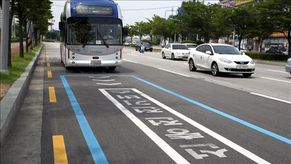|
By accessing or using The Crittenden Automotive Library™/CarsAndRacingStuff.com, you signify your agreement with the Terms of Use on our Legal Information page. Our Privacy Policy is also available there. |

Wireless Technology For Public Transport
|
|---|
|
|
Wireless Technology For Public Transport
Geoff Maxted
DriveWrite
August 28, 2013
The South Koreans are experimenting with electric buses that can charge wirelessly whilst in motion; a technology that could help ease the pollution that is slowly choking cities.
The city of Gumi, one hundred and fifty miles southeast of Seoul, is the testing ground for two so-called on-line electric vehicles, which ply a 15-mile route up to 10 times a day. The locally made buses can charge while moving or when stationary without physical contact with the power supply. At the heart of the buses is power-transfer technology that can shape electromagnetic fields in a specific direction, minimizing lost energy while in transit. Best of all for the locals is that whilst testing is in progress the rides are free.
The experiment is part of the South Korean government's effort to reduce thirty percent of the country's greenhouse-gas emissions by 2020. The government has also funded the development of hydrogen-powered engines and electric vehicles that can replace batteries at charging stations automatically.
For the heaving metropolises of the world the technology makes absolute sense. The rise of cities with 10 million inhabitants or more is expected to be pronounced, especially in the Far East, according to a 2011 United Nations study. It forecast that Asia's urban population would leap to 3.3 billion by 2050 from 1.9 billion.
The problem inevitably in trying to build in new technology to existing transport infrastructures is that it is hugely expensive. Just installing Gumi’s test routes alone cost the equivalent of over $4million. The trial buses themselves cost immense sums.
A common public concern with wireless technology is its impact on health, especially for people using pacemakers or hearing aids, although engineers say the radiation from the bus's power transfer is less than that from a laptop computer. Just now, differing frequencies seems to be the answer. Of course, electric buses have been used before only we called them trams. Obviously the new system does away with pantographs but it just goes to show that what goes around comes around.
All those cities around the world who did away with those electric buses of yore and the rails and routes they ran on must be wondering what they were thinking of. Hindsight, as they say, is a wonderful thing.




















